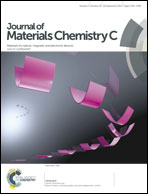Two-photon lithography in visible and NIR ranges using multibranched-based sensitizers for efficient acid generation†
Abstract
We investigated methodically the one- and two-photon absorption properties of a series of multibranched triphenylamine-based chromophores incorporating 4-(methylthio)styryl fragments as external substituents. Some relevant structure–property relationships relative to these highly fluorescent compounds have been derived based on emission anisotropy measurements, quantum chemical calculations and the use of the exciton coupling theory. Even though branching effects lead to a cooperative enhancement of the two-photon absorption (2PA), all compounds exhibit relatively low-to-moderate 2PA cross-sections (δ ≤ 100 GM) in the NIR region. However, the ‘so-called’ one-photon resonance enhancement effect leads to a remarkable increase of δ by more than one order of magnitude in the visible range. This strong 2PA ability has been associated with an efficient photosensitization of iodonium salt to elaborate a new bicomponent photoacid generator, which is readily two-photon activable at 532 nm. In the visible range, the strong enhancement of the efficiency of the two-photon induced polymerization is clearly demonstrated as compared with that observed in the NIR region.


 Please wait while we load your content...
Please wait while we load your content...